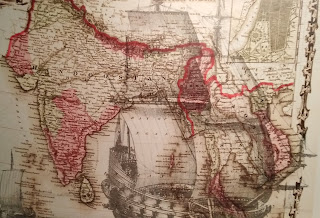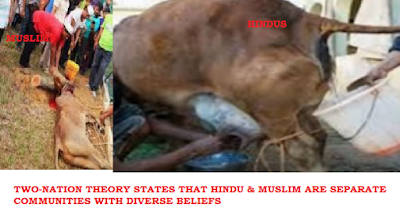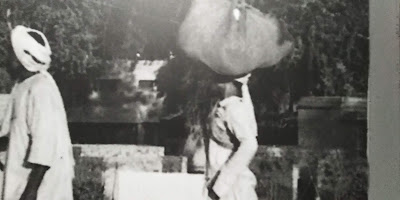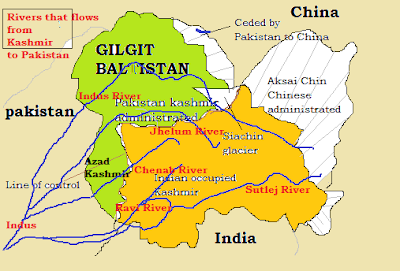Kashmir is a rainbow cake, which distributed among three nuclear powers Pakistan, India, and China who wanted the full party and it stuck in their throat. It now asks for blood to spill out. Here goes the detail and history of the Kashmir conflict and its possible solution.
JOINT HINDUSTAN
Muslims and Hindus in both countries have shared a long history under Mughal and then under British rule in joint Hindustan from the 11th century till 1947 but the movement of independence from the British struggled based on “Two nation theory” from Muslims of joint Hindustan. Muslim leaders smelled the rat at Hindu’s expected to rule when the British decided to leave.
TWO NATION THEORY
Jinnah purposed “two-nation theory” in a public meeting on 23rd March 1940. According to the “two-nation theory,ry” Muslims and Hindus are two separate nations that follow poles apart lifestyle. Muslim community cuts cows as an obligation whereas Hindus worship the animal as a mother.
Muslim community believes in one God and the Day of Judgment whereas Hindus worship deities. Their customs, religion, and eating habits don’t match at all. There should be a separate homeland for both communities to continue their religious and social virtue in peace.
STRUGGLE FOR PAKISTAN
Then Mr. Jinnah put forward an idea which was thoroughly endorsed by other leading Muslim leaders that the provinces and states with a larger number of Muslims should be declared as a separate country, named Pakistan before the British left the subcontinent. The Muslims won their demand under the logical advocacy of Muhammad Ali Jinnah and other leaders. On 3rd, 1947 the British government announced the formation of two new countries; Pakistan and India. Five Muslim majority provinces were Punjab, Sindh, Baluchistan, KPK, and Bengal were merged to form Pakistan and, rest were settled with India’s new map as bearing majority Hindu natives.
PRINCELY STATES AT TIME OF PARTITION, 1947
But the partition was not as simple as it looks or studied in books. Muslim and Hindu community was randomly distributed all over the Hindustan without giving major color to any community in many areas. The first concern was a lot of small independents princely states insides Hindustan which was asked to accede to any one country or decides to continue its autonomous position under some rules. There were 565 autonomous princely states at subcontinent other than the provinces which were headed by Nawabs or Rajahs. They were given the choice to annex to any country according to their geographical location and more of their subject’s will.
Jinnah and Nehru as heads of newly born Pakistan and India respectively, both started to convince the head of the princely states to annex with them. By July, August, September, and October 13 princely states, including Bahawalpur, Swat, Gilgit, Chitral, Dir, Amb (Mansehra), Phulra , Khairpur, Umerkot, Las Bella, Makran, Kalat decided to join Pakistan. Nawab of Hyderabad Deccan wrote to Jinnah for annexation, but for a few reasons, it couldn’t happen. Other states annexed to India with minimum retribution. Every document and agreement was going fine at least at the top-level except the state of Jammu and Kashmir. Both countries were trying hard to convince Raja Hari Singh to provide accede
STATE OF KASHMIR AT 1947
Kashmir was a state with a Muslim majority but it was headed by a Hindu Rajah, Hari Singh. The masses at Kashmir wanted to join Pakistan because they fought for independence under the two-nation theory. Now it was time to rip their efforts and also geographically Kashmir was fitter to Pakistani map. Lord Mount Baton (last viceroy of Hindustan) met Hari Singh in July and asks him to join anyone of Pakistan and India before mid of August 1947, when the British finally intended to leave for forever after switching all affairs to natives. It was important as both countries were working on their borders and other distributions at the time. Hari
LARGEST MIGRATION OF HUMANS IN 1947
The day of the final verdict for which the natives of Hindustan struggled for two centuries has arrived. The long, harsh time of slavery of British ended, and all powers were shifted to natives, to Muslims and Hindus. Mr. Jinnah and Mr. Nehru were declared the head of new countries on 14th and 15th August 1947 respectively. The world witnessed one of the largest migration of people from both borders. Muslims from all over the Indian states faced Pakistan on foot, on bull carts or by trains to embrace and to hug their homeland where they’ll live in freedom and peace. Hindus at one side were content on the withdrawal of all whites and the end of long slavery, but on the other side were cradling grievance on forming a new land for Muslims. There erupted brawl and millions of innocent Muslim men, women, and children were cut down, burnt, and deceased before reaching the borders of Pakistan.
HOW INDIA AND PAKISTAN TAKE OVER PARTS OF KASHMIR IN 1947
One month slipped and then another after August, pitiless monsoon rains ended after satisfying the rivers in an agricultural country, but leaving many ailing at immigrant camps in Pakistan.
When people at both lands were settling down their life according to a new page in history, Maharajah
FIRST WAR BETWEEN PAKISTAN AND INDIA 1947
Indian forces entered Jammu and Kashmir, which was opposed by Pakistan Army, and the first war between two freshly hatched states Pakistan and India were started which continued till 1948. Pakistan and India got control parts of Kashmir.
PAKISTAN AND INDIA IN UN ON KASHMIR ISSUE, 1947
On facing the serious confrontation from inside Kashmir and from Pakistan forces, India decided to take the matter to the United States on 1 Jan 1948 to claiming full control on Kashmir. Pakistan logically and successfully advocated the concern of Kashmiri people at UN desks that the UN Security Council passed resoulution47 on 1st Jan 1949.
UN RESOLUTION ON KASHMIR, 1947
By this resolution, the UN states that “both India and Pakistan desire that the question of the accession of Jammu and Kashmir to India or Pakistan should be decided through the democratic method of a free and impartial plebiscite.” Subsequent UNSC resolutions followed the same stand.
By this resolution, Kashmiri people were given the right to vote to show their decision. The border in Kashmir was let go as ‘line of control’ until the final solution and continue as a de facto border and both countries were asked to stay in their positions. By this India got control of two-third of Kashmir (including Kashmir valley, Jammu, and Ladakh) and Pakistan stayed at one-third which comprised Azad Kashmir and Gilgit-Baltistan.
IS GILGIT-BALTISTAN A PART OF KASHMIR OR PAKISTAN?
Gilgit-Baltistan was a part of an independent state of Kashmir before 1947, which was headed by Hindu Rajah Hari Singh as the third province. Meanwhile, when there was unrest at all Kashmir region right after partition, then people and scouts of Gilgit self helped to gain freedom from Hari Singh and by November 1, 1947, established a new state under the rule of Raja Shah Rais Khan. The new states run its affairs for 15 days and then acceded to Pakistan by consent of the public. As per history, it merged into Pakistan as the independent entity from Kashmir. The people of Gilgit are not Kashmiri too. From 1947-1970, Gilgit Baltistan was administrated through Pakistan. The administration was reshaped in 1970 and 2009 at the intense demand of people of Gilgit Baltistan, it was granted self- government under its constitution. The people of Gilgit-Baltistan have been strongly demanding to get their status in the fifth province of Pakistan. They never want to integrate into Kashmir as they emerged in Pakistan as an independent state, not under the Kashmir flag. They are patriot Pakistanis under green passport, but Pakistan by respecting the Kashmir resolution and hoping to gain the full Kashmir on an independent plebiscite, let Gilgit continue with its self-governed status under Pakistan administration.
SITUATION AT KASHMIR IN PAKISTAN
Pakistan has successfully maintained peace, development, and security at its parts of Azad Kashmir since 1947 that the world never heard about any cry from Azad Kashmir. The people of Kashmir have strong bonding and love with Pakistan. Muzzafarabad
SITUATION AT INDIAN OCCUPIED KASHMIR AND ARTICLE 370-A
On the other side, India on demand of Hari Singh, who was promised to give autonomous government added article 370-A to its constitution in 1954.
By this article, Indian occupied Kashmir was allowed to have a separate constitution, a state flag, and autonomy in internal affairs, whereas defense and foreign affairs will be a responsibility of the Indian government until the Kashmir issue is resolved as per UN resolution.
The article with Article 35 A stated that the Jammu and Kashmir people will have a separate set of laws and no change will be made to the article without the consent of Kashmir correspondents. As Kashmiri people never wanted to live under the Indian flag, so with time Indian insurgency at their land created restiveness which led to fabricate freedom movements and outbreak in Indian occupied Kashmir for decades.
The article with Article 35 A stated that the Jammu and Kashmir people will have a separate set of laws and no change will be made to the article without the consent of Kashmir correspondents. As Kashmiri people never wanted to live under the Indian flag, so with time Indian insurgency at their land created restiveness which led to fabricate freedom movements and outbreak in Indian occupied Kashmir for decades.
AFFECT OF ABROGATION OF 370-A IN KASHMIR
When on 5th August 1947 Indian Government abrogated article 35 A from its constitution without taking any Kashmir correspondent on the desk. By abrogating the article, the Indian part of Kashmir became the part of India and its autonomous position is abolished. On fearing the rebellion from natives, a communication and free movement curfew was imposed in the valley of Jammu and Kashmir. It's been more than a month when human rights violation is on hype at Kashmir. The issue of Kashmir has become a global concern now. Indian forces are patrolling and arresting the young at every corner. All internet and communication are cut down. Markets are out of medicines and food. The people of Kashmir have strongly responded to India’s cheating on their status and want to restore the article so that they can meet their dream of independence on a free referendum.
INDIA AND PAKISTAN WARS ON KASHMIR ISSUE
This Kashmir conflict caused four wars between Pakistan and India on which three 1947, 1965, 1999 were fought on Kashmir issue but the issue is still there.
WHERE DOES CHINA involve ON KASHMIR ISSUE?
Kashmir was a mountainous state amid sky rise Himalaya ranges which border Pakistan, India, and China at the time of partition. A part of Kashmir is dominated by Buddhist people and was geographically closer to China. After partition and a ceasefire between Pakistan and India in 1948, parts of Kashmir appeared on a Chinese map (China also got independence in 1948 and had its map). The controversial areas were then under the control of Pakistan then. Pakistan showed its concerns to Chinese authorities in 1961. India also claimed that part of Kashmir, so there started a war between China and India on the matter in 1962 which ended in the defeat of India, and China became the third partner in Kashmir dispute by taking over 20% of Kashmir in Aksai Chin.
SINO-PAK AGREEMENT 1963
By this agreement between the governments of Pakistan and China, Pakistan acceded 1942-5180 square kilometers to China and agreed on Chinese authority on northern Kashmir and Laddakh. Though the agreement is not recognized by India, but by fact, Kashmir is a cake which distributed among three nuclear powers who wanted the full party.
WHY KASHMIR IS SO IMPORTANT FOR PAKISTAN, INDIA, AND CHINA
After going through the conflict and present-day situation in Kashmir, the question arose why the state of Kashmir is so important which lead Pakistan, India, and China to fight major wars following the gain of atomic power to face each other. Then the simplest answer is this; Kashmir holds the world’s largest freshwater reservoir as being surrounded by a giant range of the Himalaya and Karakoram mountain ranges. Jammu and Kashmir bear many lakes, long rivers, and glaciers to fetch water, electricity, and food for millions in the region. Few of the main rivers of Kashmir are Brengi River, Chaga Tokpo River, Chang Chen Mo River, Chenab River, Chip Chap River, Indus River, Ravi River, Sutlej River, Jhelum River, Neelum River, Doda River, and the list still goes on which shows the significance of this valley.
DO PAKISTAN CLAIM ON KASHMIR FOR ITS RIVERS?
A chain of long and life-giving rivers originated from Kashmir and countries depend on them for irrigation, but Pakistan geographically is more dependent on Kashmir and have the thorough right in claiming the Kashmir not only for the demand of Kashmiri people but for the reason that rivers originated from Kashmir run through Pakistan mainly, not in India.
By leaving hold of its rivers to India, it means to give hold of its sovereignty to India, which already blackmails Pakistan on stopping the flow of water from rivers that run in Pakistan from India.
A 3200 km long river Indus originated from the Tibetan plateau, then covering 20% of it at Indian Kashmir, it runs to Pakistan. Pakistan mainly depends on this river for electricity and farming. The second big river of Pakistan is Jhelum, which also originated from Indian occupied Kashmir and straight run down to plains of Pakistan. India already blackmails Pakistan by blocking the water, altering the routes, and by constructing major dams on these rivers. Not only the same religion, but geographical parameters also suggest that Kashmir should be under Pakistan control for the survival of 21 crore
Kashmiri people hoped for their freedom and Pakistan will stand by them at every thick and thin. Pakistan will continue to advocate for the basic rights of Kasmir and that is an independent referendum where Kashmiri people can vote to which country they want to accede. Kashmir has become a global issue now and to avoid any nuclear scuffles, the world needs to address the issue on a serious note.








